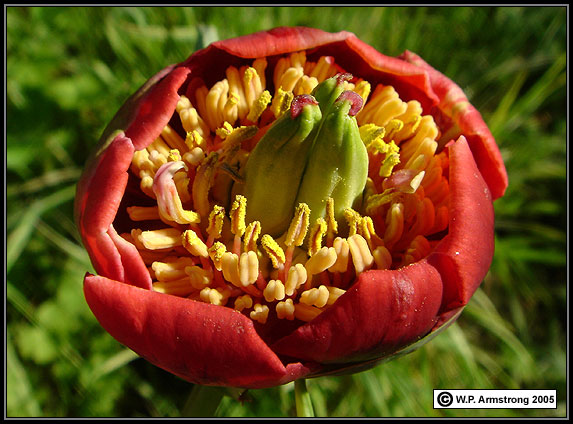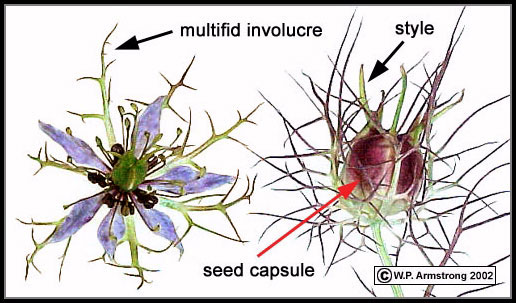|
Fruit ID #3
| Fruit Identification Photos #3 |
Larkspur Flowers, Follicles of Larkspur & Peony
& unusual flower of "Love-In-A-Mist" Nigella
Buttercup Family (Ranunculaceae)
Flowers Of The Scarlet Larkspur
|
Left: A population of scarlet larkspurs (Delphinium cardinale) in the coastal sage scrub east of Palomar College. Right: A magnificent scarlet larkspur in full bloom. The five sepals are bright red, one of which forms an elongate spur.
|
Ranunculaceae & Paeoniaceae
Follicles of the Larkspur and Peony
|
Left: The fruits of scarlet larkspur (Delphinium cardinale). Each fruit is composed of three dehiscent, many-seeded follicles. Each follicle developed from a separate carpel. The fruits of columbine (Aquilegia) are very similar except they are composed of five distinct follicles. Right: The developing fruit of a wild peony (Paeonia californica). The fruit is composed of five follicles, each developing from a separate carpel. When describing flowers such as these, the term gynoecium is preferable to the term pistil. Gynoecium is a collective term for the carpels of a flower. Monocarpous flowers are composed of one carpel (a simple pistil). The terms apocarpous and syncarpous refer to compound pistils composed of more than one carpel. Apocarpous flowers contain two or more distinct carpels (such as the larkspur and peony shown above). In syncarpous flowers, two or more carpels are fused together (connate).
|

|
Wild peony (Paeonia californica), showing many stamens and three pistils.
|
Ranunculaceae
The Bizarre Flower of Nigella damascena
|
One of the most unusual flowers in the buttercup family (Ranunculaceae) is the annual wildflower called "love-in-a mist" (Nigella damascena). Native to southern Europe, it is commonly grown in gardens of North America. The alternate leaves are pinnately dissected into threadlike (filiform) divisions, including a multifid involucre that subtends each flower. In fact, the common name "mist" is derived from the profuse, finely divided (filiform) involucre surrounding each flower. The inflated seed capsule is also surrounded by the branched, threadlike divisions of the involucre and upper leaves, resembling an intricate outer network of delicate spines. Like delphiniums and columbines, the four to five carpels of the gynoecium (compound pistil) each have a slender, erect style. Because the carpels are fused together and inflated, the entire fruit resembles a capsule (syncarpous) rather than separate distinct follicles (apocarpous); however, L.H. Bailey (Hortus Third, 1976) describes the fruit as "globular, inflated follicles united to the base." In Manual of Cultivated Plants (1924), L.H. Bailey describes the fruit as a compound ovary forming a many-seeded capsule which is exceptional to the buttercup family. According to D. Walters and D.J. Keil (Vascular Plant Taxonomy, 1977), the carpels of Nigella are connate (fused) and the fruit is a capsule.
Because the delicate, dissected leaves and aromatic seeds superficially resemble fennel (Foeniculum vulgare), the genus Nigella is sometimes referred to as wild fennel; however, it belongs to an entirely different plant family. According to S. Facciola (Cornucopia II, 1998), the seeds are used as a condiment. In fact, another Eurasian species (N. sativa) is called black cumin or fennel flower. The aromatic seeds are sprinkled on rolls, flatbreads and cakes, or used as a flavoring in curries, pickles, Armenian string cheese and in vegetable dishes. Seeds from a yellow-flowered species (N. orientalis) are sometimes used as an adulterant in black pepper.
|

|
The unusual flower of "love-in-a-mist" (Nigella damascena). The conspicuous colored segments are sepals. The actual petals are reduced to minute, clawed, two-lipped structures at the base of the stamens. Because of the unusual flower structure, this plant appears to have only one set of colored perianth segments (sepals). The seed capsule is composed of four-five fused carpels, each with a long, erect style, the entire structure surrounded by the filiform divisions of the upper leaves and involucre.
|

|
Close-up views of the unusual flower of "love-in-a-mist" (Nigella damascena). The conspicuous, colored perianth segments are sepals. The actual petals are reduced to minute, clawed, two-lipped structures at the base of the stamens (see magnified view at right). The gynoecium (pistil) is composed of four or five carpels, each with an erect style. Depending on the reference, the fruit is composed of four or five carpels which are fused into an inflated, many-seeded capsule.
|
|





